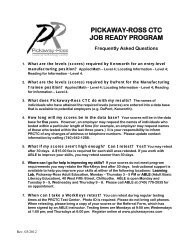Commons
Conceptual Physics - elearning-phys
Conceptual Physics - elearning-phys
- No tags were found...
Create successful ePaper yourself
Turn your PDF publications into a flip-book with our unique Google optimized e-Paper software.
c / Albert Michelson, in 1887,the year of the Michelson-Morleyexperiment.d / George FitzGerald, 1851-1901.e / Hendrik Lorentz, 1853-1928.m/s relative to the sidewalk, and I run after it at 3 m/s, the dog’svelocity in my frame of reference is 2 m/s. According to everythingwe have learned about motion, the dog must have different speedsin the two frames: 5 m/s in the sidewalk’s frame and 2 m/s in mine.How, then, can a beam of light have the same speed as seen bysomeone who is chasing the beam?In fact the strange constancy of the speed of light had alreadyshown up in the now-famous Michelson-Morley experiment of 1887.Michelson and Morley set up a clever apparatus to measure anydifference in the speed of light beams traveling east-west and northsouth.The motion of the earth around the sun at 110,000 km/hour(about 0.01% of the speed of light) is to our west during the day.Michelson and Morley believed in the ether hypothesis, so they expectedthat the speed of light would be a fixed value relative to theether. As the earth moved through the ether, they thought theywould observe an effect on the velocity of light along an east-westline. For instance, if they released a beam of light in a westward directionduring the day, they expected that it would move away fromthem at less than the normal speed because the earth was chasingit through the ether. They were surprised when they found that theexpected 0.01% change in the speed of light did not occur.Although the Michelson-Morley experiment was nearly two decadesin the past by the time Einstein published his first paper onrelativity in 1905, he probably did not even know of the experimentuntil after submitting the paper. 4 At this time he was still workingat the Swiss patent office, and was isolated from the mainstream ofphysics.How did Einstein explain this strange refusal of light waves toobey the usual rules of addition and subtraction of velocities due torelative motion? He had the originality and bravery to suggest aradical solution. He decided that space and time must be stretchedand compressed as seen by observers in different frames of reference.Since velocity equals distance divided by time, an appropriate distortionof time and space could cause the speed of light to comeout the same in a moving frame. This conclusion could have beenreached by the physicists of two generations before, but the attitudesabout absolute space and time stated by Newton were so stronglyingrained that such a radical approach didn’t occur to anyone be-4 Actually there is some controversy on this historical point. The experimentin any case remained controversial until 40 years after it was first performed.Michelson and Morley themselves were uncertain about whether the result wasto be trusted, or whether systematic and random errors were masking a realeffect from the ether. There were a variety of competing theories, each of whichcould claim some support from the shaky data. For example, some physicistsbelieved that the ether could be dragged along by matter moving through it,which inspired variations on the experiment that were conducted in tents withthin canvas walls, or with part of the apparatus surrounded by massive leadwalls.76 Chapter 4 Relativity



